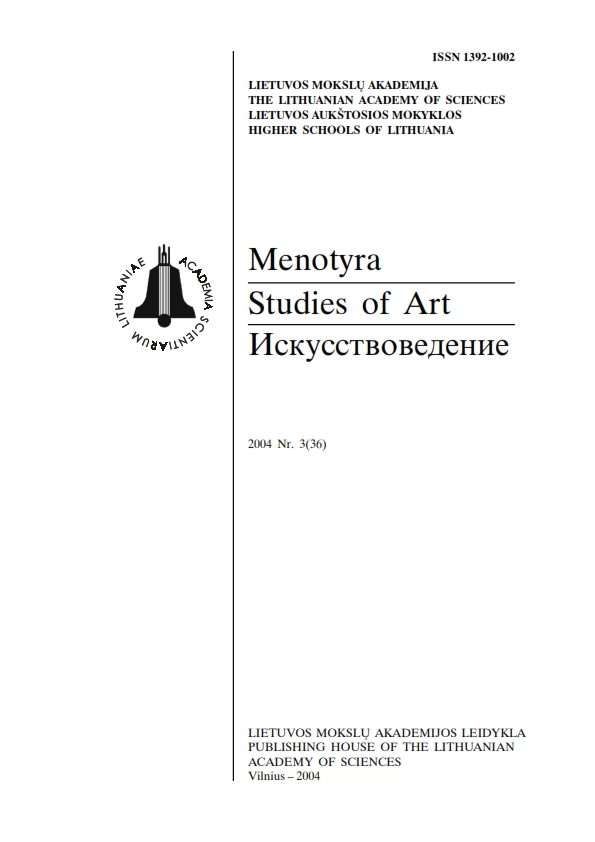Vilniaus arkikatedros tekstilė XVI a. inventoriuose
Textile fabrics in Vilnius Cathedral in the light of archival documents of the 16th century
Author(s): Gražina Marija MartinaitienėSubject(s): Christian Theology and Religion, Cultural history, Visual Arts, Economic history, Sociology of Culture, Sociology of Art
Published by: Lietuvos mokslų akademijos leidykla
Summary/Abstract: The article analyzes archival documents of Vilnius Cathedral dating from the 16th century and on the basis of the records discovered attempts establishing how many and what fine textile valuables were held at that time in the most significant Lithuanian Catholic shrine.Research into the earliest surviving documents of the cathedral, which date from the 16th century (inventories of 1552 and 1598), first of all revealed a large quantity and variety of textile articles of different purposes. It may be presumed that this was conditioned by the complex rituals of the time with well-developed scenarios, colourful scenography and a large number of performers. They required elaborate costumes and a variety of other objects that would give meaning to and adorn the place of action. In the late 16th century, the cathedral had more than one hundred examples of the main liturgical vestment - chasuble - alone, forty pieces of copes of several kinds (pluviales), the same quantity of dalmatics and tunicles, not to mention a variety of small accessories to these vestments. The altars of the cathedral and its chapels were adorned by seventy sewn and embroidered antependia and a number of various coverings. Dozens of veils and burses were used to cover chalices at Mass.On the basis of the inventory descriptions of every piece, which are quite professional and detailed, it was established that the largest portion of the liturgical vestments of the cathedral as well as other sacral and decorative pieces have been made from ornate and extremely expensive Italian fabrics. Especially popular were shiny brocade fabrics with precious-metal threads and different varieties of velvet, such as classical velvet, cloth-of-gold, and velvet brocade. These fabrics and articles made of them were adorned employing various techniques of decoration.In accordance with the inventories, the main motifs of decoration include various flowers woven into garlands, symbolic images, and figurines of saints. In most cases the latter were embroidered - not only in coloured silk threads but also in gold and silver threads, pearls and jewels. Pearls were especially popular – they are abundant on the robes and crowns of the saints.The inventories state that figural motifs largely appeared on the crosses and bands of chasubles, shields of copes, and the central part or the upper bands of antependiums. Among the most popular themes were crucified Jesus with mourning figures, the Holy Trinity, and the Virgin and Child surrounded by saints and/or angels. The central part of antependiums, amices, covers and some other embroidery pieces were frequently adorned with the abbreviation IHS, which signifies Jesus. The inventory of the year 1598 describes coats of arms and emblems that have been embroidered on some liturgical vestments, coverings and antependiums. They allow the researchers identifying the patrons and benefactors. Special attention deserves objects with the emblems of the Polish-Lithuanian Commonwealth – Vytis of the Grand Duchy of Lithuania and the Polish Eagle. These are gifts from the Commonwealth's ruler, most likely Sigismund Augustus. There is a number of black-colour needlework pieces with both state emblems and the third one – that of the Radvila family. Most probably these articles were devoted to the funeral rites of the young queen Barbora Radvilaitė who died in 1551. Judging by the inventory descriptions of other emblems, the most generous benefactors in the 16th century were the noble Goštautas family, the bishops of Vilnius Paulius Algimantas Alšėniškis (?-1536-1555), Valerijonas Protasevičius (1504-1556-1579) and Benediktas Vaina (1556?-1600-1615) as well as a number of clergymen of a lower rank and noble laypeople.The author discusses also the destiny of the liturgical vestments and other objects that have been kept in the Cathedral's treasury and describes some extant valuables.
Journal: Menotyra
- Issue Year: 2004
- Issue No: 3(36)
- Page Range: 10-16
- Page Count: 7
- Language: Lithuanian

